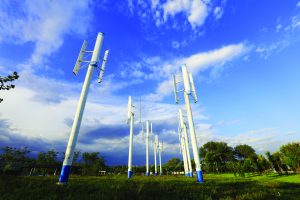Historically, the wind energy industry has been unreceptive to implementing simulation training as a viable alternative for standard training methods. Trade leaders have acknowledged that this primarily stems from a longstanding practice of using traditional, yet effective, on-the-job training (OJT) methods. The industry-wide lack of understanding on simulation benefits is another reason for their delayed adoption. The industry may not be aware of the operational savings and safety benefits aligned with a more technologically advanced training option. Wind energy trade members stand to benefit from learning how simulation modules can be integrated into their existing training program as a supplemental resource.
Current State of Training within the Wind Energy Industry
The “Occupational Outlook Handbook” projects that the need for wind turbine service technicians will increase to 108 percent by 2024 (http://www.bls.gov, 2016). The demand for this skilled workforce greatly exceeds the availability of qualified workers, and entry-level training can often take six to eight months to complete. This fact highlights another challenge within the training realm — student throughput. An ongoing issue within the industry has been the absence of a successful method that alleviates the training backlog. Companies must also accommodate the travel costs associated with sending existing technicians to remote training locations stateside and internationally. The good news is that student throughput and travel funding concerns aren’t novel or insurmountable in the global training arena. The steady adoption of virtual environments as a supplemental training tactic by government agencies and commercial companies has resulted in reduced operating expenses and improved student performance.

An Example of Simulation Training Used in the U.S. Government
The United States Navy, originating in 1775 and touted as the largest employer in the world, accounts for more than 328,000 personnel, 272 combat vessels, and 3,700 aircraft currently in active service (www.navy.com, 2016). In the case of undersea initiatives prior to 2010, sailors were sent to multiple training sites to complete tasks using the actual tactical hardware. This resulted in hefty travel expenses, setup costs, and repair fees. Furthermore, this training method was limited to pre-established hardware configurations so it lacked flexibility in recreating troubleshoot and maintenance scenarios. In 2010, the Navy identified and implemented a solution to aid in reducing their training costs. The multipurpose reconfigurable training system (MRTS) was developed using affordable commercial off-the-shelf (COTS) hardware, such as monitors and computers that feature realistic 2-D and 3-D models, touch-based gestures, and touchscreen technology to simulate tasks that were originally only performed on the tactical equipment. The format of the MRTS trainer was designed so that the configuration of the virtual components could be altered by the instructor to reflect a vessel-specific version of a radio room. The intent for this solution was to offer students an entry-level training tool for maintenance and operator tasks that can be easily shipped to and distributed in multiple naval bases and facilities worldwide. As a result, the U.S. Navy yielded a savings of over $100 million with the use of this new virtual environment training technology.
A Case for Simulation Training in the Wind Energy Industry
While the majority of wind energy OEMs has opted to rely solely on the use of OJT, one global wind power firm recently engaged in a feasibility study to determine the efficacy and cost savings of developing a simulation training solution for service technicians. The company faced a multitude of training barriers that all pointed back to two principal issues — throughput and costs. In an effort to streamline their approach, they partnered with JHT Inc., a training and simulation firm based in Orlando, Florida, to develop a comprehensive business case for a tailored solution aligned with their technical requirements and training environment. The team at JHT Incorporated proposed the wind turbine simulation trainer (WTST). The construct of the WTST is a reconfigurable simulation system for performing authentic maintenance tasks and troubleshooting procedures on multiple wind turbine platforms. With implementation of the WTST, the wind energy firm aimed to realize an optimum balance of cost, reliability, adaptability, and effectiveness.
The primary objectives identified in developing the trainer included:
• Reducing operational costs associated with technical training on turbine equipment
• Meeting the demand for qualified maintenance and troubleshooting technicians
• Achieving troubleshooting excellence and business impact while preserving the safety of technicians
• Cost Benefit Analysis for Wind Turbine Simulation Trainer
The solution, comprised of a virtual 3-D environment and embedded with a realistic simulation of their turbine system, involved student interaction with the components of the wind turbine system through a multi-touch display. A predetermined number of simulated faults were designed for service technicians including: firmware upgrades, power, hydraulic, and lock-out/tag-out procedures using a library of realistic touch gestures from the ProxSIMity™ advanced touch system. The integration of ProxSIMity afforded students the ability to emulate over 100 pressure-sensitive actions within a 2-D or 3-D environment designed specifically for touchscreen-based applications.

The Latest in Touch Technology
The use of gesture-based simulation training has found support across many industries including the medical equipment manufacturing sector. A current international conglomerate has integrated ProxSIMity into a customized training solution aimed at training maintenance technicians on several of their medical imaging modalities. Their tailored solution, using COTS 55” touchscreen monitors and computer towers, integrates student training stations (STS) and an instructor operating station (IOS), thereby allowing instructors to conduct classes, assign tasks and procedures, and monitor student performance in cities around the world. They now spend a fraction of previous years’ costs on training expenditures.
Conclusion
The future for simulation training across all industries as a supplemental tool for OJT is expected to grow significantly as the case for cost savings, ease of throughput, and meeting customer demands becomes more substantiated. The availability of customized, cost-efficient 3-D simulation training solutions optimized for use on affordable COTS hardware presents a strong case that the wind energy industry will also benefit from reconsidering the advantages of their adoption and implementation.
For more information, go to www.jht.com/proxSIMity.


































